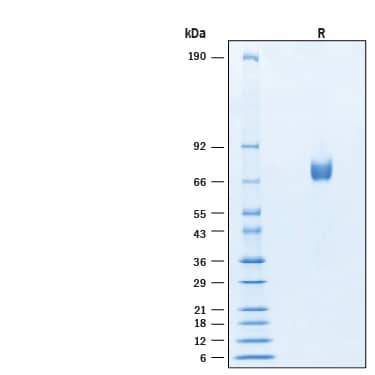Recombinant Human NRG1-beta 1/HRG1-beta 1 Fc Protein, CF
R&D Systems, part of Bio-Techne | Catalog # 11610-NR

Key Product Details
Source
Structure / Form
Conjugate
Applications
Product Specifications
Source
| Human NRG1-beta1 (Ser 20-Lys 246) Accession # NP_039250.2 |
GGIEGRMD | Human IgG1 (Pro100-Lys330) |
| N-terminus | C-terminus |
Purity
Endotoxin Level
N-terminal Sequence Analysis
Predicted Molecular Mass
SDS-PAGE
Activity
The ED50 for this effect is 2.00-20.0 ng/mL.
Scientific Data Images for Recombinant Human NRG1-beta 1/HRG1-beta 1 Fc Protein, CF
Recombinant Human NRG1-beta 1/HRG1-beta 1 Fc Chimera Protein Bioactivity.
Recombinant Human NRG1-beta 1/HRG1-beta 1 Fc Chimera Protein (Catalog # 11610-NR) induces the proliferation of MCF-7 human breast cancer cells.Recombinant Human NRG1-beta 1/HRG1-beta 1 Fc Chimera Protein SDS-PAGE.
2 μg/lane of Recombinant Human NRG1-beta 1/HRG1-beta 1 Fc Chimera Protein (Catalog # 11610-NR) was resolved with SDS-PAGE under reducing (R) condition and visualized by Coomassie® Blue staining, showing bands at 66-73 kDa.Formulation, Preparation and Storage
11610-NR
| Formulation | Lyophilized from a 0.2 μm filtered solution in PBS with Trehalose. |
| Reconstitution | Reconstitute at 500 μg/mL in sterile water. |
| Shipping | The product is shipped at ambient temperature. Upon receipt, store it immediately at the temperature recommended below. |
| Stability & Storage | Use a manual defrost freezer and avoid repeated freeze-thaw cycles.
|
Background: Neuregulin-1 beta 1/NRG1 beta 1
The Neuregulin family of structurally related glycoproteins comprises products from four distinct but related genes, Nrg-1, Nrg-2, Nrg-3, and Nrg-4. Through alternative splicing or the use of alternative promoters, Nrg-1 has been shown to encode more than 14 soluble or transmembrane proteins. The extracellular domain of the transmembrane NRG1 isoforms can be proteolytically cleaved to release soluble growth factors. All NRG1 isoforms contain an EGF-like domain ( alpha- or beta-splice variant that differ in their C-terminal region) that is required for their direct binding to the ErbB3 or ErbB4 receptor tyrosine kinases. The ErbB3 or ErbB4 subsequently recruits and heterodimerizes with ErbB2, resulting in tyrosine phosphorylation and NRG1 signaling. NRG1 isoforms can be classified into three major subtypes. Type I (Neu Differentiation Factor, NDF; Heregulin, HRG; Acetylcholine Receptor Inducing Activity, ARIA) and type II (Glial Growth Factor, GGF) NRG1s have an immunoglobulin (Ig)-like domain N-terminal to the EGF-like domain. Type I NRG1s differ from type II NRG1s by having a glycosylation-rich domain between the Ig-like and the EGF-like domains. Type III NRG1s (Sensory and Motor neuron-Derived Factor) lacks the Ig-like domain but has a cysteine rich domain (CRD) instead. NRG1 isoforms show distinct spatial and temporal expression patterns. These proteins play important roles during development of both the nervous system and the heart. They have been shown to regulate the selective expression of neurotransmitter receptors in neurons and at the neuromuscular junction, and promote the differentiation and development of Schwann cells from neural crest stem cells. NRG1s have also been shown to be involved in the establishment of the oligodendroglial lineage.
References
- Buonanno, A., and G.D Fischbach (2001) Curr. Opin. Neurobiol. 11:287.
- Adlkofer, K. and C. Lai (2000) Glia 29:104.
- Garratt, A.N. et al., (2000) BioEssays 22:987.
Alternate Names
Gene Symbol
Additional Neuregulin-1 beta 1/NRG1 beta 1 Products
Product Documents for Recombinant Human NRG1-beta 1/HRG1-beta 1 Fc Protein, CF
Product Specific Notices for Recombinant Human NRG1-beta 1/HRG1-beta 1 Fc Protein, CF
For research use only

